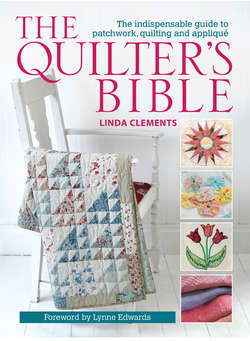Читать книгу The Quilter's Bible - Linda - Страница 16
На сайте Литреса книга снята с продажи.
ОглавлениеWaddings (Battings)
Wadding (or Batting) is the material layered between two fabrics to form a quilt’s padding. There are many types, made from different materials. Wadding is made by bonding or needle punching, both intended to secure the fibres together. When bonded, a resin is used and the wadding may be completely bonded or only surface bonded. A needle-punched wadding has the fibres pieced by needles, which causes them to tangle together.
The wadding you choose depends on the type of quilting planned and how the item will be used. Some are fine for machine quilting but are more difficult to hand quilt through, while others are very puffy and work best for tied quilts. Some need to be quilted at tightly spaced intervals of 2in (5cm) while others may only need to be quilted every 10in (25.4cm) or so. Waddings are also available with a heat-resistant layer, useful for table and kitchen linen. Some waddings are fusible, which helps when securing the layers of a quilt together. Generally, try to match the wadding with the quilt material, for example, cotton wadding for cotton fabrics, silk for silk and so on. Waddings often shrink when washed, producing the attractive crinkled quality of old quilts. If you don’t want this effect then wash the wadding before use. Wadding is available in pre-cut pieces to fit standard mattress sizes – see Useful Information.
‘Loft’ refers to the weight and thickness of a wadding. Low-loft waddings are thinner than high-loft ones, which are puffier. ‘Bearding’ is a term used to describe how a wadding can break down, allowing fibres to work their way to the right side of the fabric. This may occur with cheap waddings so always buy the best you can afford. ‘Request’ weight waddings are lightweight with low loft and are good for hand quilting.
Types of Wadding (Batting)
Cotton – This is finer, heavier and warmer than polyester wadding and is very suitable for machine quilting. It can be hand quilted, though this needs to be quite close, about 2in (5cm), between lines. Cotton waddings do not work well as tied quilts as the wadding can break up unless secured at closely spaced intervals.
Wool – Natural fibre waddings breathe well and are usually comfortable all year long. Wool waddings are suitable for hand quilting, being easy to stitch through.
Silk – This natural fibre wadding is expensive so isn’t the first choice for a large quilt, however its fineness makes it perfect for quilted garments.
Bamboo – This natural fibre product has a low loft and quilts well. It is very soft and has antibacterial properties so could be useful for baby quilts.
Polyester – This is made from synthetic fibres and is available in different weights, including a thin 2oz (60g) and a thicker 10oz (300g). It is usually the least expensive, washes well and creates a lightweight quilt. Bearding may be a problem. Lower loft polyester waddings can be hand or machine quilted but thicker weights will be difficult to machine quilt. High loft types are great for tied quilts. Do not use a hot iron on polyester wadding.
Blended – Wadding may also be made from blended fibres, for example, 80 per cent cotton and 20 per cent polyester or 50 per cent cotton and 50 per cent soy protein. Blended waddings tend to be more stable and less apt to shift.
Interfacings, Stabilizers and Fusible Webs
Interfacings and stabilizers are used to line, stiffen and stabilize fabrics, while fusible web is used to glue one fabric to another and is particularly useful for appliqué work. These materials are available in different weights, usually light, medium and heavy. As a general rule, match the weight with the fabric weight.
Interfacings – This may be sew-in or fusible, the fusible sort having a heat-activated coating on one side, which allows it to be glued to a fabric. It is usually single sided but double-sided types are available. In patchwork, appliqué and quilting an interfacing such as Vilene is used to stiffen or give shape to fabrics, particularly delicate ones or those that fray badly. It can be used as a base when foundation piecing or for crazy patchwork. Different weights are available and stiffer (heavy) weights are useful in bag making and for three-dimensional patchwork.
Stabilizers – These materials are used to stabilize fabrics, making them firmer to stitch on, and are available in different weights. Stabilizers can be temporary, being torn away or dissolved when stitching is finished, or be permanent and left in place. They can be sew-in or fusible. Interfacing may sometimes be referred to as a stabilizer. Muslin and calico can also be used as stabilizers.
Fusible webs – These are made of an ultra-thin sheet of adhesive backed with a special paper. The heat of an iron causes the adhesive to melt and so fuse two fabrics together. Once fused, it forms a secure bond and prevents edges fraying. It comes in different weights, usually light, medium and heavy. Many brands are available and may vary slightly, so always read the manufacturer’s instructions before use. See Fusible Web Appliqué for more on using fusible web.
